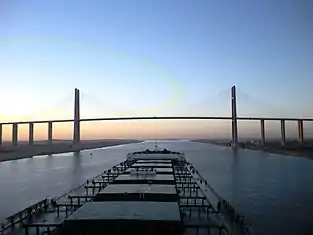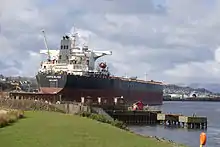Capesize
Capesize ships are the largest dry cargo ships. They are too large to transit the Suez Canal (Suezmax limits) or Panama Canal (Neopanamax limits),[1] and so have to pass either the Cape of Good Hope or Cape Horn to traverse between oceans.

When the Suez Canal was deepened in 2009, it became possible for some capesize ships to transit the canal and so changed categories.
Classification


Ships in this class are bulk carriers, usually transporting coal, ore and other commodity raw materials. The term capesize is not applied to tankers. The average size of a capesize bulker is around 156,000 DWT, although larger ships (normally dedicated to ore transportation) have been built, up to 400,000 DWT. The large dimensions and deep drafts of such vessels mean that only the largest deep-water terminals can accommodate them.[3]
Subcategories of capesize vessels include very large ore carriers (VLOC) and very large bulk carriers (VLBC) of above 200,000 DWT. These vessels are mainly designed to carry iron ore.
References
- Clark, Iain J. (2014-02-19). Commodity Option Pricing: A Practitioner's Guide. Wiley. pp. 267–. ISBN 9781444362404. Retrieved 11 April 2014.
- STRICKEN Ship Will be Biggest At Inchgreen Berth For Decades Archived 2014-03-04 at the Wayback Machine, Inverclyde Now 28 February 2014
- "Modern ship size definitions" (PDF). Lloyd's Register. Jan 3, 2014. Archived from the original (PDF) on December 26, 2014. Retrieved April 23, 2015..